Iain D. Couzin
Towards Application-Specific Evaluation of Vision Models: Case Studies in Ecology and Biology
May 05, 2025Abstract:Computer vision methods have demonstrated considerable potential to streamline ecological and biological workflows, with a growing number of datasets and models becoming available to the research community. However, these resources focus predominantly on evaluation using machine learning metrics, with relatively little emphasis on how their application impacts downstream analysis. We argue that models should be evaluated using application-specific metrics that directly represent model performance in the context of its final use case. To support this argument, we present two disparate case studies: (1) estimating chimpanzee abundance and density with camera trap distance sampling when using a video-based behaviour classifier and (2) estimating head rotation in pigeons using a 3D posture estimator. We show that even models with strong machine learning performance (e.g., 87% mAP) can yield data that leads to discrepancies in abundance estimates compared to expert-derived data. Similarly, the highest-performing models for posture estimation do not produce the most accurate inferences of gaze direction in pigeons. Motivated by these findings, we call for researchers to integrate application-specific metrics in ecological/biological datasets, allowing for models to be benchmarked in the context of their downstream application and to facilitate better integration of models into application workflows.
3D-MuPPET: 3D Multi-Pigeon Pose Estimation and Tracking
Aug 29, 2023



Abstract:Markerless methods for animal posture tracking have been developing recently, but frameworks and benchmarks for tracking large animal groups in 3D are still lacking. To overcome this gap in the literature, we present 3D-MuPPET, a framework to estimate and track 3D poses of up to 10 pigeons at interactive speed using multiple-views. We train a pose estimator to infer 2D keypoints and bounding boxes of multiple pigeons, then triangulate the keypoints to 3D. For correspondence matching, we first dynamically match 2D detections to global identities in the first frame, then use a 2D tracker to maintain correspondences accross views in subsequent frames. We achieve comparable accuracy to a state of the art 3D pose estimator for Root Mean Square Error (RMSE) and Percentage of Correct Keypoints (PCK). We also showcase a novel use case where our model trained with data of single pigeons provides comparable results on data containing multiple pigeons. This can simplify the domain shift to new species because annotating single animal data is less labour intensive than multi-animal data. Additionally, we benchmark the inference speed of 3D-MuPPET, with up to 10 fps in 2D and 1.5 fps in 3D, and perform quantitative tracking evaluation, which yields encouraging results. Finally, we show that 3D-MuPPET also works in natural environments without model fine-tuning on additional annotations. To the best of our knowledge we are the first to present a framework for 2D/3D posture and trajectory tracking that works in both indoor and outdoor environments.
3D-POP -- An automated annotation approach to facilitate markerless 2D-3D tracking of freely moving birds with marker-based motion capture
Mar 23, 2023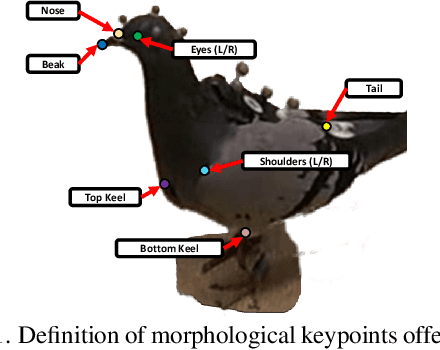
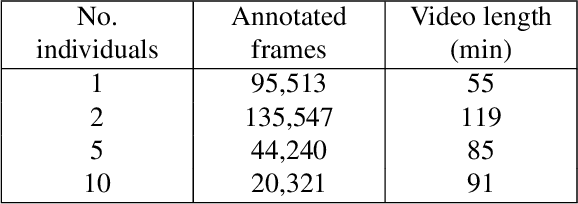
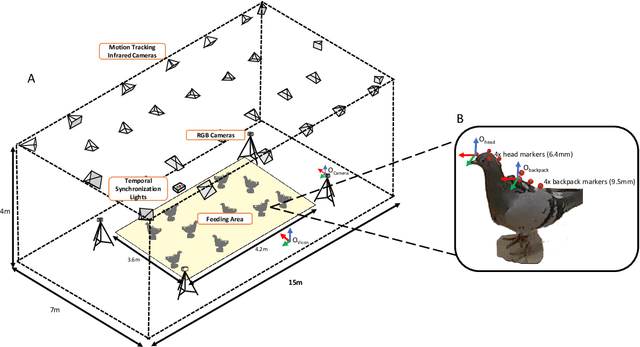

Abstract:Recent advances in machine learning and computer vision are revolutionizing the field of animal behavior by enabling researchers to track the poses and locations of freely moving animals without any marker attachment. However, large datasets of annotated images of animals for markerless pose tracking, especially high-resolution images taken from multiple angles with accurate 3D annotations, are still scant. Here, we propose a method that uses a motion capture (mo-cap) system to obtain a large amount of annotated data on animal movement and posture (2D and 3D) in a semi-automatic manner. Our method is novel in that it extracts the 3D positions of morphological keypoints (e.g eyes, beak, tail) in reference to the positions of markers attached to the animals. Using this method, we obtained, and offer here, a new dataset - 3D-POP with approximately 300k annotated frames (4 million instances) in the form of videos having groups of one to ten freely moving birds from 4 different camera views in a 3.6m x 4.2m area. 3D-POP is the first dataset of flocking birds with accurate keypoint annotations in 2D and 3D along with bounding box and individual identities and will facilitate the development of solutions for problems of 2D to 3D markerless pose, trajectory tracking, and identification in birds.
Seeing biodiversity: perspectives in machine learning for wildlife conservation
Oct 25, 2021
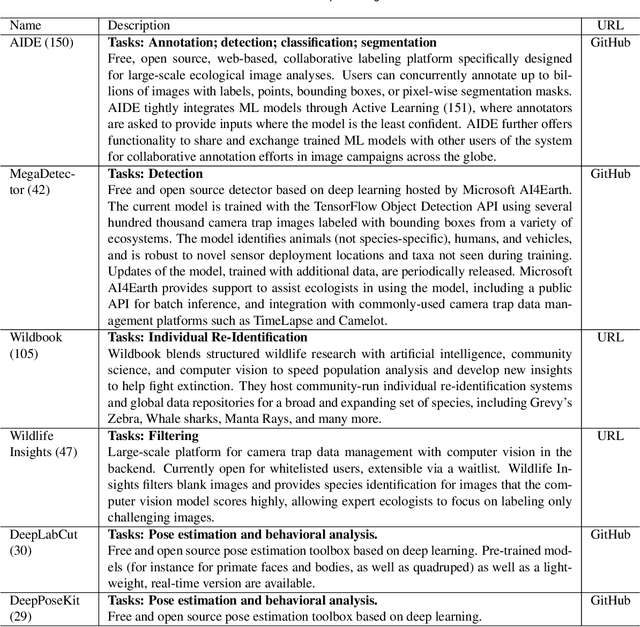

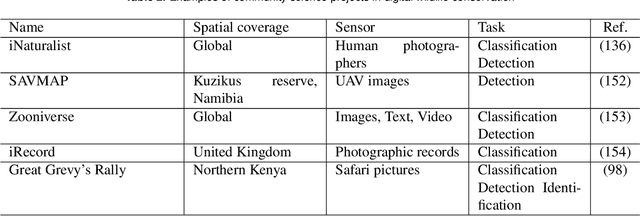
Abstract:Data acquisition in animal ecology is rapidly accelerating due to inexpensive and accessible sensors such as smartphones, drones, satellites, audio recorders and bio-logging devices. These new technologies and the data they generate hold great potential for large-scale environmental monitoring and understanding, but are limited by current data processing approaches which are inefficient in how they ingest, digest, and distill data into relevant information. We argue that machine learning, and especially deep learning approaches, can meet this analytic challenge to enhance our understanding, monitoring capacity, and conservation of wildlife species. Incorporating machine learning into ecological workflows could improve inputs for population and behavior models and eventually lead to integrated hybrid modeling tools, with ecological models acting as constraints for machine learning models and the latter providing data-supported insights. In essence, by combining new machine learning approaches with ecological domain knowledge, animal ecologists can capitalize on the abundance of data generated by modern sensor technologies in order to reliably estimate population abundances, study animal behavior and mitigate human/wildlife conflicts. To succeed, this approach will require close collaboration and cross-disciplinary education between the computer science and animal ecology communities in order to ensure the quality of machine learning approaches and train a new generation of data scientists in ecology and conservation.
 Add to Chrome
Add to Chrome Add to Firefox
Add to Firefox Add to Edge
Add to Edge